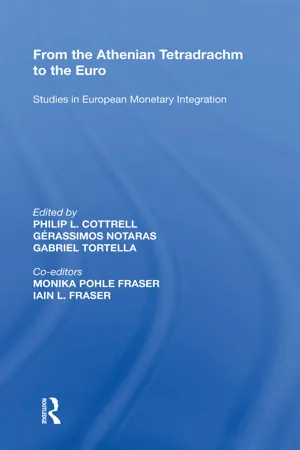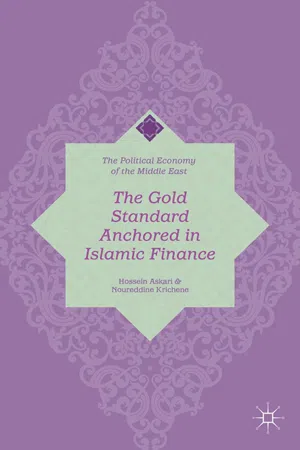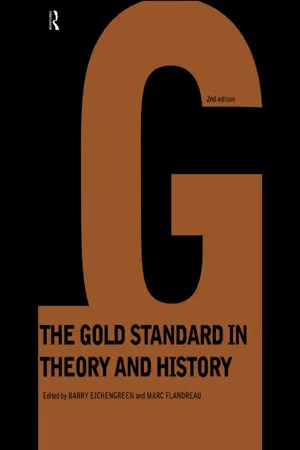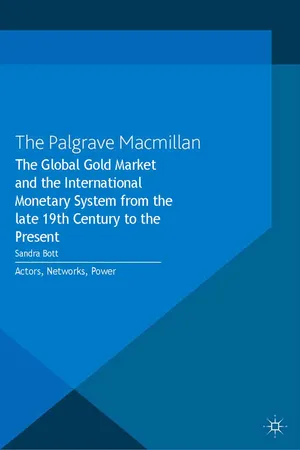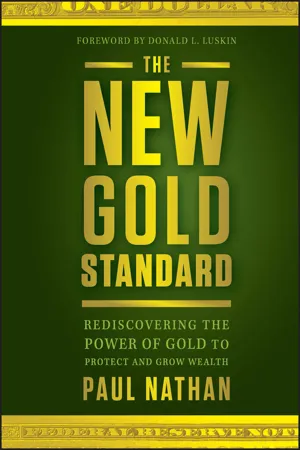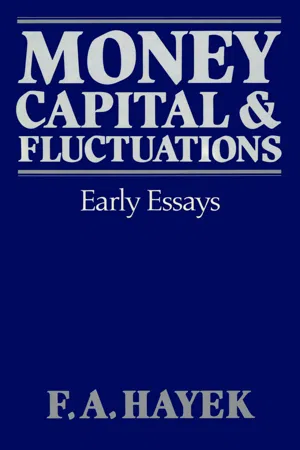Economics
Gold Standard
The gold standard was a monetary system where a country's currency was directly linked to a specific amount of gold. Under this system, the value of a country's currency was determined by the fixed price of gold. The gold standard was widely used in the 19th and early 20th centuries but was eventually abandoned by most countries in favor of fiat currency systems.
Written by Perlego with AI-assistance
Related key terms
Related key terms
1 of 4
Related key terms
1 of 3
12 Key excerpts on "Gold Standard"
- eBook - ePub
From the Athenian Tetradrachm to the Euro
Studies in European Monetary Integration
- Gérassimos Notaras(Author)
- 2017(Publication Date)
- Routledge(Publisher)
The Gold Standard: A Review from the PeripheryPablo Martín-AceñaIntroduction
The period from 1880 to 1914, known as the heyday of the Gold Standard, was a remarkable one in world economic history. It was an era of globalization, marked by remarkable economic growth, substantial transfers of productive resources and rapid technological change. Under its aegis, a widespread system of fixed exchange parities was maintained from the 1880s until 1914. Entirely voluntary participation in the Gold Standard was a notable aspect of this regime, and despite a number of international crises, it functioned with surprising smoothness. Moreover, it appears to have done so with little, if any, international cooperation.This legendary international monetary regime emerged during the late nineteenth century, when the majority of countries switched from bimetallism and paper to gold as the basis for their currencies. As an international standard, the key rule was the maintenance of gold convertibility at a previously established parity. The fixed price of gold ensured fixed exchange rates that, in turn, provided a nominal anchor to the international monetary system. Thus, an economy is said to be on the Gold Standard when its monetary unit's gold content is fixed by law. In addition, the institutions issuing fiduciary money are under legal obligation to exchange, at any time, any amount of gold specie for fiduciary currency, and vice versa, while any amount of bullion will be coined on request by the mint. Finally, the authorities must allow unrestricted international movements of specie and bullion and, more generally, free capital mobility. Using current terminology, the Gold Standard is an exchange regime characterized by a fixed exchange rate, free convertibility and perfect capital mobility. - eBook - ePub
- H. Askari, N. Krichene(Authors)
- 2014(Publication Date)
- Palgrave Macmillan(Publisher)
5 The Gold StandardIn each Gold Standard country, gold was the standard of value; gold coin was the money with unlimited legal tender. Exchange rates were fixed by the ratios of gold content in respective gold coins. Banks, brokers, and bullion dealers settled transactions within and across countries with negligible movements of gold.Many fallacies arose concerning the gold money. These fallacies were confused by the apparent cheapness of paper substitutes and called for displacing gold by paper or making paper a representative of gold. Besides fallacies, gold money suffered the assault of inflationism. Gold was a commodity and could not be issued out of thin air, in contrast to paper money, which could be issued in a limitless manner out of thin air. Governments needed paper to finance wars and bureaucracies. Gold was dealt a fatal blow and replaced by paper money. In this chapter, we cover:• Definition of the Gold Standard• Institutions—goldsmiths, banks, Treasury, emit paper currency and banknotes convertible into gold at par• Examples of Gold Standard regimes—US dollar, British sterling, each money defined in weight of gold• Instruments of payments that economize on gold: bank notes, bills of exchange promissory notes, the banking system, clearing houses.• Theories on economizing on gold• Major controversies surrounding gold• No monetary policy in the Gold StandardDefinition of the Gold StandardThe Gold Standard was the commodity money system that existed in most countries from prehistorical times until it was abolished by Western governments in 1914. A Gold Standard country used gold as a standard measure of value and money for settlings domestic and international trade. The Gold Standard evolved through the centuries. Before the advent of paper money, gold circulated in the form of coins and bullion. With the advent of the banking system, banknotes, and government issued currency, gold was replaced by notes, which were, in theory, redeemable at par, that is, at a fixed rate. No paper currency circulated across borders. A trade imbalance between two trading countries was settled with gold. If country A’s coin was worth 5 grams of pure gold and country B’s coin was worth 2 grams of pure gold, the exchange rate was 5/2=2.5. No country was able to destabilize another country through inflationary policies. If a country expanded its paper and credit, it lost its gold. - eBook - ePub
- H. L. Puxley(Author)
- 2017(Publication Date)
- Routledge(Publisher)
The Gold Standard and its Future, London, 1932, p. 9. With stable exchange rates, an American trader can deal in goods priced in sterling as simply as in goods priced in dollars.1 “The quantity of circulating credit tends to hold a definite relation to the quantity of money in circulation.”—Irving Fisher, Purchasing Power of Money, p. 50. The quantity of money in circulation, in turn, was supposed to be closely linked to the size of the country’s gold holdings.1 “Any fall in the value of gold in one country (indicated by a rise in prices in that country) relative to the value of gold in other gold-standard countries would generate a movement of gold out of that country into those other countries where its values are greater. Inflow to those countries would tend to lower its value there, i.e. to raise prices; and the efflux from the country which lost some of its gold would tend to raise its value in that country, i.e. to lower prices. And these two sets of forces would continue to be effective until equilibrium was restored…. In short, the operation of the Gold Standard … tended to establish a price-stability between countries.”—D. T. Jack, Economics of the Gold Standard, London, 1925, p. 25.1 “The Territorial Distribution of money is effected through the agency of Prices. If the stock of money in any country becomes so large that, its rate of movement being what itis, goods offered in the market for money can be exchanged as often as required, and yet a higher level of prices be maintained than in other countries, that country becomes a good country to sell to, because prices there are high, and, for the same reason, becomes a bad country to buy from. The immediate consequence is that exports of domestic products from a country having such a scale of prices are diminished, while its imports of foreign merchandise are increased. If, then, the money of that country is such as has equal acceptance in foreign countries, a movement for its exportation to settle the disturbed balance of exchange at once begins.”—F. A. Walker, Money, Trade and Industry - eBook - ePub
- Barry Eichengreen, Marc Flandreau(Authors)
- 2005(Publication Date)
- Routledge(Publisher)
He could secure forthwith, if he wished it, cheap and comfortable means of transit to any country or climate without passport or other formality, could despatch his servant to the neighboring office of a bank for such supply of the precious metals as might seem convenient, and could then proceed abroad to foreign quarters, without knowledge of their religion, language, or customs, bearing coined wealth upon his person, and would consider himself greatly aggrieved and much surprised at the least interference. But, most important of all, he regarded this state of affairs as normal, certain, and permanent. 5 The classical Gold Standard was a remarkably uncomplicated mechanism. To be ‘on gold’, a country simply fixed a legal value in national currency at which the monetary authorities (typically the mint or the central bank) would buy or sell gold. This effectively established a fixed legal rate of exchange between gold and the currency, and thus between all other gold-standard currencies and the national currency. A number of subsidiary ‘rules of the game’, not formal but widely understood, were designed to ensure that the government would be able to guarantee free convertibility of the currency into gold. 6 The economic implications of the Gold Standard were also quite simple and were understood in late medieval times. If a country ran a persistent trade deficit, gold would flow out and the money supply would contract. 7 This would drive domestic prices down relative to world prices, thus increasing exports and reducing imports—and bringing trade back into balance. The process ran in reverse for countries with persistent surpluses. To repeat the points made more generally above, a credible commitment to gold provided economic agents with a marvelously predictable exchange rate, but it also greatly restricted the ability of national governments to affect national monetary conditions - eBook - ePub
Balance of Payments
Theory and Economic Policy
- Robert Stern(Author)
- 2017(Publication Date)
- Routledge(Publisher)
This brief historical survey revealed a number of important differences between the idealized version and observed operation of the Gold Standard. In short, the Gold Standard was in actuality far more complex and functioned much less automatically than the idealized version of it implies. The special historical circumstances of economic growth in the pre-1914 period also cannot be overlooked. We had occasion thereafter to examine the abortive attempts to reinstitute the Gold Standard during the interwar period, and to consider the implications of adapting the present-day international financial system along gold-standard lines. The important question here was whether countries would willingly expose themselves to domestic instability in order to maintain exchange-rate stability. We stepped finally outside of the Gold Standard and examined in more general terms the case to be made for a system of fixed exchange rates and the special conditions that would have to be met for such a system to function effectively. Having treated the major considerations involved in freely fluctuating and fixed exchange-rate systems, we can turn in the next chapter to the present-day system of the adjustable peg. The issue here is whether the present-day system represents the better or the worse of both possible exchange-rate worlds. 1 This account of the adjustment mechanism under the Gold Standard is very much oversimplified. In particular, we have not spelled out the relationships between the demand for goods and for money and between national income and expenditure that make the system operative and lead to equilibrium when a disturbance occurs - eBook - ePub
Gold and the Gold Standard
The Story of Gold Money, Past, Present and Future
- Dr. Edwin Walter Kemmerer(Author)
- 2018(Publication Date)
- Papamoa Press(Publisher)
{185} the value of gold does vary materially. A change in the purchasing power of the dollar in a given year, as in the United States in 1921, when it rose 10 per cent, or in 1937, when it fell 7 per cent, is serious; and more serious still is a continuous depreciation or appreciation over a period of years, as for the periods 1896 to 1910 and 1882 to 1886, respectively.Rigidity
A third weakness, which is closely related to the two just mentioned but more questionable, is the rigidity of the unit of value. Under the Gold Standard, the unit of value cannot be easily changed as a means of adapting a national economy to the business cycle, to secular changes in the business world, and to the occasional violent disturbance. In order to obtain the advantages of a largely automatic monetary system and of stable foreign-exchange rates, a gold-standard nation must forego the privilege of manipulating its monetary unit to any considerable degree.Expensiveness
Expensiveness is a fourth defect of the Gold Standard. In this connection, Adam Smith’s statements are familiar.{186} Speaking of the use of bank notes as media of exchange, he said:The substitution of paper in the room of gold and silver money, replaces a very expensive instrument of commerce with one much less costly, and sometimes equally convenient....The gold and silver money which circulates in any country may very properly be compared to a highway, which, while it circulates and carries to market all the grass and corn of the country, produces itself not a single pile of either. The judicious operations of banking, by producing, if I may be allowed so violent a metaphor, a sort of wagon way, through the air; enables the country to convert, as it were, a great part of its highways into good pastures and corn fields, and thereby to increase very considerably the annual produce of its land and labour. - eBook - ePub
- S. Bott(Author)
- 2013(Publication Date)
- Palgrave Macmillan(Publisher)
required government action. Brazil and Mexico were brought to attempting to institute the Gold Standard by what political scientist Stephen Krasner and others call ‘international regimes’ – a consensus on the rules of the international commercial game, and domestically ‘double-edged diplomacy’ – an eye to both external and internal interests, as Robert Putnam argues, rather than simply being the offspring of the inexorable gears of commerce (Krasner 1978 and 1999; Putnam 1993). In other words, politics, both international and national, imposed themselves on key economic decisions.And the political significance of the Gold Standard as well as its enforcement varied greatly. Unfortunately, though, for those of us who study the world outside Europe, the Gold Standard has been viewed mostly from a Europe-centred perspective. As Barry Eichengreen and Marc Flandreau have written: ‘By focusing on the experience of Western Europe and North America, most of their studies run the risk of distorting the geography of the monetary system and hence of misrepresenting its evolution‘ (Eichengreen and Flandreau 1994, p.2). This brief review of the attempted transition to the Gold Standard in Brazil and Mexico seeks to provide a larger international context for understanding monetary regimes.To key leaders in both countries, especially the powerful ministers of finance, gold (and here, gold is shorthand for precious metals including silver) represented stability, seriousness of purpose, economic progress and modernity, and obeisance to the laws of the self-regulating market (Limantour 1965; Hale 1989, pp. 124–38; Murtinho 1899, pp. 175–216). Its appeal is well summed up in the motto of both Brazil, which placed it on the new Republican flag, and of Mexico: Order and Progress - eBook - ePub
Karl Polanyi's Political and Economic Thought
A Critical Guide
- Gareth Dale, Christopher Holmes, Maria Markantonatou, Gareth Dale, Christopher Holmes, Maria Markantonatou(Authors)
- 2019(Publication Date)
- Agenda Publishing(Publisher)
2 When there is less money, its value increases and market actors have to compete harder to get it. In the case of the Gold Standard, this would have been achieved by forcing banks to back their banknotes with reserves of gold, a rare metal that made it more difficult to create new money.What makes perfect sense at a formal and logical level, however, often proves to be misleading when looking at concrete history. For example, it is difficult to square this thesis with the fact that the Gold Standard, far from restricting the supply of money in the nineteenth century, witnessed instead the broad diffusion of banknotes as a form of money. As a result, Britain saw its supply of money increase more rapidly than that of other European countries in the early decades of the nineteenth century.3 It was a trajectory that strongly contrasted the experience of the interwar period, which Polanyi knew much better and when the Gold Standard did have a clear deflationary impact. Yet he failed to appreciate the differences between these two eras and projected back a conception of the Gold Standard that had little to do with the circumstances that surrounded the creation of this institution a century earlier.Part of the problem is that Polanyi never really delved into the historical complexities of this case. Instead, he relied on formal writings from economists that were never properly contextualized. It is striking how Polanyi shifts register when he moves from labour and land to money, the last of his three fictitious commodities. Here, his analysis of the Gold Standard curiously fails to go beyond the deductive templates of classical political economy. The chapter on the commodification of money is the only one of his three studies of fictitious commodities that makes virtually no historical references either to the policies surrounding the adoption and development of the Gold Standard in the nineteenth century, or to the writings of classical political economists about the Gold Standard.4 - eBook - ePub
The New Gold Standard
Rediscovering the Power of Gold to Protect and Grow Wealth
- Paul Nathan(Author)
- 2011(Publication Date)
- Wiley(Publisher)
Under the rules established by the Bretton Woods agreement, the gold values of a member nation’s currency could be altered as conditions warranted. This distinguishing feature of the Bretton Woods system exposed a drastic ideological departure from the Gold Standard.Under the Gold Standard, no natural conditions would ever warrant a change in the gold value of a nation’s currency. Under a pure Gold Standard, all the money in circulation would be either gold or claims to gold. Any paper money would be fully convertible into gold. There would be no difference between claims to gold and gold itself, since, if claims to gold circulated as money, the gold could not.However, there are government-made conditions that could warrant a reduction in the gold value of a nation’s currency. If governments have the power to artificially increase the claims to gold (e.g., dollars), they have the power to depreciate the value of the national monetary unit.Bretton Woods was established with the intention of aiding governments in exercising their powers of inflationary finance. Government leaders knew that the Gold Standard prevented them from fully pursuing domestic goals that depended on deficit spending and prolonged, artificially induced booms. They detested the Gold Standard for its fixed rules, which brought adverse economic repercussions whenever they refused to adhere to them, and they detested flexible exchange rates that exposed the government’s policy of currency depreciation.The political temptations of artificially increasing the money supply in order to stimulate the economy prevailed against the Gold Standard and brought the beginning of a new era: fixed exchange rates with flexible rules, the exact opposite of the Gold Standard.No longer would politicians adhere to the discipline of the Gold Standard. No longer would they have to restrict their deficits or domestic money supplies. Government leaders would make their own rules and fix the nominal value of money by decree. And if conditions warranted a reduction in the nominal value of a nation’s money, it was agreed that a nation could devalue up to 10 percent after the formality of obtaining other nations’ permission. This was called the adjustable peg system. - eBook - ePub
Money, Capital, and Fluctuations
Early Essays
- F. A. Hayek, R. K. McCloughry(Authors)
- 2018(Publication Date)
- University of Chicago Press(Publisher)
That the otherwise conservative managements of the central banks deviated in a relatively light-hearted manner from the traditional rules of monetary policy can be attributed to the influence of new ideas on monetary policy, propagated by the academic fraternity, which obtained wide circulation during the post-war years. In order to understand what actually happened, therefore, a brief consideration of the origin and significance of these new ideas is necessary.The rise of the concept of stabilizationWhat must be remembered first of all is that, as a result of the general paper money inflation in Europe and the associated drift of gold to America after the end of the war, gold was devalued to such an extent that precisely at the time when the return to the Gold Standard was the most pressing need in most European countries, in America the fact that even gold did not constitute a completely satisfactory basis for a currency in all circumstances was felt more strongly than ever before. Little attention was paid to the fact that even this fall in the value of gold had only occurred because of the abandonment of the Gold Standard in Europe, and would never have reached the stage that it did had not the few countries which had maintained gold payments used the cessation of competition for gold so as also to inflate, though at a lower rate than those which had departed from gold.The second important factor which determined the development of ideas on monetary policy was that the above-mentioned facts were partly contributory to the extraordinary influence exercised by two particular representatives of the mechanistic Quantity Theory of Money and of the concept of a systematic stabilization of the price level, Professors Irving Fisher and Gustav Cassel. The fluctuations in the value of money mentioned above necessarily aroused wide interest in Professor Fisher’s proposal for stabilizing the value of gold, which he had been advocating for a long time; and the lively propaganda which was being circulated, particularly by the Stable Money Association which he had founded, had succeeded in making the concept of price stabilization as the objective of monetary policy into a virtually unassailable dogma. Professor Cassel, who deserved the greatest credit for the stabilization of European currencies, contributed a further, extraordinarily effective argument in favour of the policy of stabilization, the influence of which upon actual developments it is impossible to overestimate. - eBook - ePub
The Collected Works of F. A. Hayek
The New World
- F. A. Hayek, Stephen Kresge(Authors)
- 2012(Publication Date)
- University of Chicago Press(Publisher)
THREETHE FATE OF THE Gold Standard1There has been much talk about the breakdown of the Gold Standard, particularly in Britain where, to the astonishment of every foreign observer, the abandonment of the Gold Standard was very widely welcomed as a release from an irksome constraint. However, it can scarcely be doubted that the renewed monetary problems of almost the whole world have nothing to do with the tendencies inherent in the Gold Standard, but on the contrary stem from the persistent and continuous attempts from many sides over a number of years to prevent the Gold Standard from functioning whenever it began to reveal tendencies which were not desired by the country in question. Hence it was by no means the economically strong countries such as America and France whose measures rendered the Gold Standard inoperative, as is frequently assumed, but the countries in a relatively weak position, at the head of which was Britain, who eventually paid for their transgression of the ‘rules of the game’ by the breakdown of their Gold Standard.That the otherwise conservative managements of the central banks deviated in a relatively lighthearted manner from the traditional rules of monetary policy can be attributed to the influence of new ideas on monetary policy, propagated by the academic fraternity, which obtained wide circulation during the postwar years. In order to understand what actually happened, therefore, a brief consideration of the origin and significance of these new ideas is necessary. - eBook - ePub
- Barry Eichengreen, Jaime Reis, Jorge Braga de Macedo(Authors)
- 2005(Publication Date)
- Routledge(Publisher)
Monetary Problems of the International Economy, Chicago: University of Chicago Press, pp.61–89.Young, John Parke (1925), Central American Currency and Finance, Princeton: Princeton University Press.Passage contains an image
COMMENT
Angela Redish
In this time of uncertainty over monetary regimes, it is natural to see what can be learned from historical experience. Correspondingly, over the last few decades the classical Gold Standard has been used as a case-study by those attempting to measure the impact of alternative monetary regimes for price stability, output cycles and economic growth.1 The papers presented in Chapters 3 and 5 look for rather different lessons—what are the causes of changes in monetary regimes and how are transitions between monetary regimes effected? While it is possible that the choice of regime may have implications for (for example) price and output stability, it does not necessarily follow that it was the search for such behavior that led to the regime change. Indeed, the two papers discussed here emphasize the role of historical contingency and political symbolism in the ascendancy of the Gold Standard.Let me begin with Alan Milwards’ discussion of the origins of the Gold Standard. The central thrust of his paper is that Germany's adoption of the Gold Standard in the 1870s had a domino effect and led to the international spread of the Gold Standard. Germany's decision, in turn, he attributes to the desire by a politically powerful liberal bourgeoisie, not for deflation as is sometimes supposed, but for economic development and growth.2 This group believed that the Gold Standard would ‘guarantee…a liberal middle class constitutional order’.The overall story here is internally consistent and yet I think there are gaps in the argument that need to be addressed to make the case compelling. I would like to see the link between German adoption of the Gold Standard and subsequent choices by other European powers expanded upon. Was the fall in the price of silver resulting from Germany's silver sales the primary channel of influence, or was it the desire for fixed exchange rate with major trading partners? This latter effect, which Milward emphasizes for example in the case of Scandinavia, needs elaboration. For example, in Chapter 6 , on Portugal's adoption of the Gold Standard, Jaime Reis argues that the Portuguese in 1854 were rather nervous about adopting the same monetary standard as their major trading partner, for fear that the Portuguese economy would be less insulated from Britain. Similarly, there is now a debate over whether Canada should fix its exchange rate with the United States, a debate which to date has been won by the ‘no’ side.3
Index pages curate the most relevant extracts from our library of academic textbooks. They’ve been created using an in-house natural language model (NLM), each adding context and meaning to key research topics.
Explore more topic indexes
Explore more topic indexes
1 of 6
Explore more topic indexes
1 of 4
